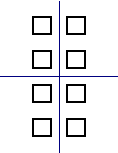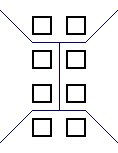|
|||
|
This article presents a method for determining relationship in setups beyond what has been approved by Callerlab. This is perhaps a proposal.
|
|||
(Reference: section on relationship from FASR and Other Square Dance Terminology Explained)
Relationship is how the boy sequence is related to the girl sequence -or- how a reference dancer is positioned relative to his or her partner.
Once the formation, arrangement, and sequence are specified, there is yet another piece of information we will need before we can call an Allemande Left or Right and Left Grand, etc. That is Relationship. The simplest way to illustrate relationship is to start with a squared set and have everyone Join Hands and Circle To The Left. Each boy has his partner girl to his right. Now call Put The Ladies In And The Men Sashay. Notice that the formation is still a circle, the arrangement is still alternating B, G, B, G, etc., and both the boys and girls are "in sequence" (1, 2, 3, 4 going around the ring in promenade direction). But each boy no longer has his partner girl to his right. What changed was the relationship the dancers have with their partners.
There are 4 relationships denoted by the letters p, c, o, r...
What is a reference boy?
The reference boy is the boy dancer of the reference pair. The reference pair is comprised of 2 opposite sex dancers in the formation that we will use to determine how the boy sequence is related to the girl sequence. This will determine which of the 4 relationships we have. It is somewhat arbitrary which dancers we choose for the reference pair and it unfortunately makes a definite difference, affecting which letter (p, c, o, r) gets assigned, especially in sequence states 3 and 4 where one of the boys may have his partner while the other has opposite girl. It is important that reference dancers be chosen based on positions within a formation, rather than by any one specific dancer throughout the tip, otherwise Relationship will depend on the Sequence, and we do not want that. (this is explained further below)
Which is the reference pair?
This is still a topic of debate in Callerlab committee meetings. There are convenient choices one can make, but ultimately the choice is somewhat arbitrary. What has been agreed upon is which dancers make up the reference pair (the reference boy and the one girl he is adjacent to for purposes of establishing the relationship) in 4 formations with standard sex arrangement only: [L], [B], [F], and [W].
Reference Pair shown in RED
        |
        |
        |
        |
| Lines | Box / 8-Chain | 2-Face Lines | R-H Waves |
Relationship in other formations and arrangements
Note - The following extensions to relationship notation are my own and are not approved by Callerlab
I find it necessary throughout this website to use relationship to describe setups involving other formations and in particular, other arrangements. To do this I extended the definitions of "adjacent dancers" and "reference boy".
Dividing Arbitrary Formations into Pairs of Adjacent Dancers
If the formation is standard arrangement facing lines, it is easy to have "Adjacent to" simply mean "temporary partner at the moment". For other formations, notably [P], the reference boy may be adjacent to more than one girl. His temporary partner is not always the girl we will want to use to determine relationship. 7In some arrangements, temporary partners may be same-sex. This causes a problem because the whole idea of relationship is to relate the boy's sequence to the girl's sequence.
So to address these problems, I want to introduce the concept of quadrants of the square. Quadrants are fourths (1/4) of the square - like pie slices - that have one boy and one girl in each. The boy and girl in each quadrant form pairs for the purpose of selecting a reference pair to define relationship. Therefore we define "adjacent dancers" as "the girl and boy in the same quadrant of the square".
There are two fundamental ways to divide the square into quadrants for purposes of determining relationship.
 |  |
We will always choose to divide the square as shown on the left. It is also important to get one boy and one girl in each quadrant.
Quadrant
Reference Pair shown in RED
        |
        |
        |
        |
(not finished - more explanation coming soon)